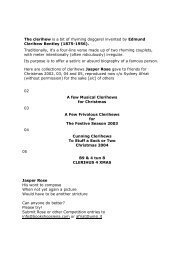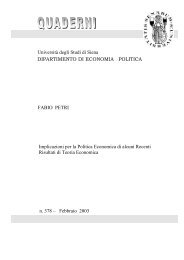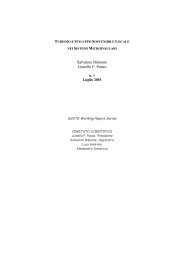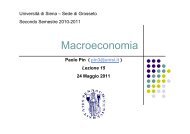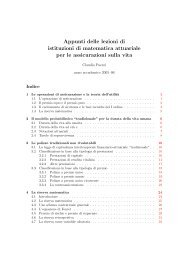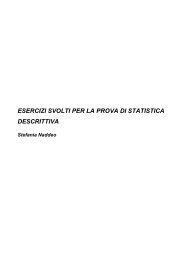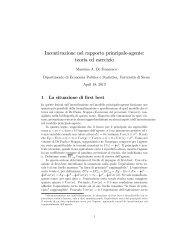università degli studi di siena facoltà di scienze matematiche, fisiche ...
università degli studi di siena facoltà di scienze matematiche, fisiche ...
università degli studi di siena facoltà di scienze matematiche, fisiche ...
You also want an ePaper? Increase the reach of your titles
YUMPU automatically turns print PDFs into web optimized ePapers that Google loves.
♦<br />
J ∪ H =<br />
J =<br />
A B C<br />
a1 b1 c1<br />
a1 b1 c2<br />
a2 b1 c1<br />
a3 b1 c1<br />
a1 b2 c2<br />
A B C<br />
a1 b1 c1<br />
a1 b1 c2<br />
a2 b1 c1<br />
a3 b1 c1<br />
J ∩ H =<br />
H =<br />
A B C<br />
a1 b1 c1<br />
A B C<br />
a1 b1 c1<br />
a1 b2 c2<br />
J − H =<br />
A B C<br />
a1 b1 c2<br />
a2 b1 c1<br />
a3 b1 c1<br />
¬J è composto invece dalle 14 possibili terne che non appartengono a J.<br />
Continuiamo a considerare le istanze per quella che è la loro struttura:<br />
elementi della potenza finita <strong>di</strong> un prodotto cartesiano. Il prodotto cartesiano<br />
suggerisce imme<strong>di</strong>atamente un altro semplice operatore insiemistico, quello<br />
<strong>di</strong> proiezione.<br />
Definizione 6 . Dato un record s sul prodotto cartesiano D1×D2×. . .×Dn<br />
ed un dominio Di ∈ {D1, D2, . . ., Dn}, si definisce proiezione <strong>di</strong> s su Di<br />
l’elemento <strong>di</strong> ∈ Di appartenente ad s, cioè l’i-esimo elemento <strong>di</strong> s. Scriveremo:<br />
πDi (s[d1, . . .<strong>di</strong>−1, <strong>di</strong>, <strong>di</strong>+1, . . ., dn]) = <strong>di</strong> . ♦<br />
In seguito useremo anche l’operatore inverso della proiezione:<br />
π −1<br />
Di : Di −→ P(D1 × D2 × . . . × Dn) .<br />
Non è assolutamente detto che il risultato <strong>di</strong> questa funzione sia un’istanza,<br />
anzi, se uno solo <strong>degli</strong> altri dominî, oltre a Di, ha car<strong>di</strong>nalità infinita, anche<br />
il risultato <strong>di</strong> π −1<br />
sarà un insieme infinito <strong>di</strong> records.<br />
Di<br />
Una volta definito un operatore dai records agli elementi dei dominî,<br />
proseguiamo con uno da records a records.<br />
Definizione 7 . Dato un record s sul prodotto cartesiano D1 × D2 × . . . ×<br />
Dn ed un insieme <strong>di</strong> dominî {Di1, Di2, . . .,Dim} ⊂ {D1, D2, . . .,Dn}, si<br />
definisce proiezione <strong>di</strong> s su {Di1, Di2, . . .,Dim} il record:<br />
14



